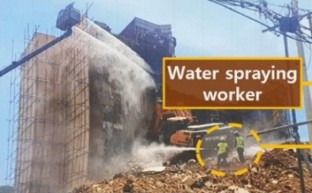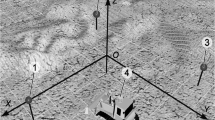Abstract
Construction sites involving excavators often generate substantial amounts of fine dust at the operating position of the excavator bucket. To address the problem, this research proposes a system that tracks the excavator’s bucket using only a single camera and an artificial intelligence-based image recognition algorithm, aiming to improve accuracy and efficiency compared to conventional methods that utilize multiple sensors. To enhance the accuracy of image recognition, a bucket dataset containing background images was utilized. Real-time object tracking performance exceeding 30 FPS was achieved by applying a graphics processing unit optimizer. Moreover, a function was implemented to track a specific object when multiple objects with similar characteristics are detected. The system also features a control system that utilizes these functions to apply a pan-tilt motion mechanism to the camera, enabling the tracking of the identified bucket position. Extensive experiments, including image recognition for tracking objects exhibiting various motion trajectories and estimating the position of invisible objects, have been conducted to validate the performance of the system.




















Similar content being viewed by others
References
Karkhanis, V., & Joshi, J. M. (2011). Cement dust exposure-related emphysema in a construction worker. Lung India: Official Organ of Indian Chest Society, 28(4), 294–294. https://doi.org/10.4103/0970-2113.85694
Tong, R., Cheng, M., Zhang, L., Liu, M., Yang, X., Li, X., & Yin, W. (2018). The construction dust-induced occupational health risk using Monte-Carlo simulation. Journal of Cleaner Production, 184, 598–608. https://doi.org/10.1016/j.jclepro.2018.02.286
Haynes, R., & Savage, A. (2007). Assessment of the health impacts of particulates from the redevelopment of kings cross. Environmental Monitoring and Assessment, 130, 47–56. https://doi.org/10.1007/s10661-006-9449-5
Mondal, A. K., Mondal, S., Devalla, V., Sharma, P., & Gupta, M. K. (2016). Advances in floating aerogenerators: Present status and future. International Journal of Precision Engineering and Manufacturing, 17, 1555–1568. https://doi.org/10.1007/s12541-016-0182-x
Sharma, A., Mondal, S., Mondal, A. K., Baksi, S., Patel, R. K., Chu, W. S., & Pandey, J. K. (2017). 3D printing: It’s microfluidic functions and environmental impacts. International Journal of Precision Engineering and Manufacturing-Green Technology, 4, 323–334. https://doi.org/10.1007/s40684-017-0038-6
Yu, H., Cheng, W., Peng, H., & Xie, Y. (2018). An investigation of the nozzle’s atomization dust suppression rules in a fully-mechanized excavation face based on the airflow-droplet-dust three-phase coupling model. Advanced Powder Technology, 29(4), 941–956. https://doi.org/10.1016/j.apt.2018.01.012
Zhang, Y., Tang, W., Li, H., Guo, J., Wu, J., & Guo, Y. (2022). The evaluation of construction dust diffusion and sedimentation using wind tunnel experiment. Toxics, 10(8), 412. https://doi.org/10.3390/toxics10080412
Gambatese, J. A., & James, D. E. (2001). Dust suppression using truck-mounted water spray system. Journal of Construction Engineering and Management, 127(1), 53–59. https://doi.org/10.1061/(ASCE)0733-9364(2001)127:1(53)
Lee, S., Park, H., & Chu, B. (2022). Excavator posture estimation and position tracking system based on kinematics and sensor network to control mist-spraying robot. IEEE Access, 10, 107949–107960. https://doi.org/10.1109/ACCESS.2022.3212732
Arshi, O., & Mondal, S. (2023). Advancements in sensors and actuators technologies for smart cities: A comprehensive review. Smart Constr. Sustain. Cities, 1, 18. https://doi.org/10.1007/s44268-023-00022-2
Sharma, N., Pandey, J. K., & Mondal, S. (2023). A review of mobile robots: applications and future prospect. International Journal of Precision Engineering and Manufacturing, 24, 1695–1706. https://doi.org/10.1007/s12541-023-00876-7
Pandey, U., Pathak, A., Kumar, A., & Mondal, S. (2023). Applications of artificial intelligence in power system operation, control, and planning: A review. Clean Energy, 7(6), 1199–1218. https://doi.org/10.1093/ce/zkad061
Ghosh, K., Pandey, U., Pathak, A., & Mondal, S. (2023). Simulation of density based traffic control system using proteus 7.1 professional. In G. Mathur, M. Bundele, A. Tripathi, & M. Paprzycki (Eds.), Proceedings of 3rd international conference on artificial intelligence: advances and applications: ICAIAA 2022 (pp. 493–504). Singapore: Springer Nature Singapore. https://doi.org/10.1007/978-981-19-7041-2_41
Soltani, M. M., Zhu, Z., & Hammad, A. (2017). Skeleton estimation of excavator by detecting its parts. Automation in Construction, 82, 1–15. https://doi.org/10.1016/j.autcon.2017.06.023
Lee, S., & Lee, S. (2022). Recent advances of artificial intelligence in manufacturing industrial sectors: A review. International Journal of Precision Engineering and Manufacturing (IJPEM), 23, 111–129. https://doi.org/10.1007/s12541-021-00600-3
Park, S. (2023). Improving image monitoring performance for underwater laser cutting using a deep neural network. International Journal of Precision Engineering and Manufacturing (IJPEM), 24, 671–682. https://doi.org/10.1007/s12541-023-00771-1
Chiddarwar, S. (2023). Integrating virtual twin and deep neural networks for efficient and energy-aware robotic deburring in industry 4.0. International Journal of Precision Engineering and Manufacturing (IJPEM), 24, 1517–1534. https://doi.org/10.1007/s12541-023-00875-8
Ren, Z., Fang, F., & Yan, N. (2022). State of the Art in Defect Detection Based on Machine Vision. Int. J. of Precis. Eng. and Manuf.-Green Tech. 9, 661–691. https://doi.org/10.1007/s40684-021-00343-6
Kong, J. H., & Lee, S. W. (2023). Development of melt-pool monitoring system based on degree of irregularity for defect diagnosis of directed energy deposition process. International Journal of Precision Engineering and Manufacturing-Smart Technology, 1(2), 137–143. https://doi.org/10.57062/ijpem-st.2023.0045
Wojke, N., Bewley, A., & Paulus, D. (2017). Simple online and real-time tracking with a deep association metric. IEEE International Conference on Image Processing (ICIP), 2017, 3645–3649. https://doi.org/10.1109/ICIP.2017.8296962
Bochkovskiy, A., Wang, C. Y., & Liao, H. Y. (2020). YOLOv4: Optimal speed and accuracy of object detection. arXiv preprint arXiv:2004.10934. https://doi.org/10.48550/arXiv.2004.10934
Choi, E., & Kim, J. (2020). Deep learning based defect inspection using the intersection over minimum between search and abnormal regions. International Journal of Precision Engineering and Manufacturing, 21, 747–758. https://doi.org/10.1007/s12541-019-00269-9
Kim, S. W., Kong, J. H., & Lee, S. W. (2022). Recent advances of artificial intelligence in manufacturing industrial sectors: A review. International Journal of Precision Engineering and Manufacturing, 23, 111–129. https://doi.org/10.1007/s12541-021-00600-3
Vanholder, H. (2016). Efficient Inference with TensorRT. GPU Technology Conference, 1, 2.
Kwak, J., Lee, S., & Baek, J. (2022). Autonomous UAV target tracking and safe landing on a leveling mobile platform. International Journal of Precision Engineering and Manufacturing, 23, 305–317. https://doi.org/10.1007/s12541-021-00617-8
Liu, P., Chi, H. L., Li, X., & Guo, J. (2021). Effects of dataset characteristics on the performance of fatigue detection for crane operators using hybrid deep neural networks. Automation in Construction, 132, 103901. https://doi.org/10.1016/j.autcon.202
Shahinfar, S., Meek, P., & Falzon, G. (2020). “How many images do I need?” Understanding how sample size per class affects deep learning model performance metrics for balanced designs in autonomous wildlife monitoring. Ecological Informatics, 57, 101085. https://doi.org/10.1016/j.ecoinf.2020.101085
Acknowledgements
This research was supported by the MSIT (Ministry of Science and ICT), Korea, under the ICAN (ICT Challenge and Advanced Network of HRD) program (IITP-2024-RS-2022-00156394), supervised by the IITP (Institute of Information & Communications Technology Planning & Evaluation).
Author information
Authors and Affiliations
Corresponding author
Additional information
Publisher's Note
Springer Nature remains neutral with regard to jurisdictional claims in published maps and institutional affiliations.
Rights and permissions
Springer Nature or its licensor (e.g. a society or other partner) holds exclusive rights to this article under a publishing agreement with the author(s) or other rightsholder(s); author self-archiving of the accepted manuscript version of this article is solely governed by the terms of such publishing agreement and applicable law.
About this article
Cite this article
Shin, J., Park, H., Jeong, H. et al. Image-Recognition-Based Embedded System for Excavator Bucket Tracking in Construction Sites. Int. J. Precis. Eng. Manuf. (2024). https://doi.org/10.1007/s12541-024-01025-4
Received:
Revised:
Accepted:
Published:
DOI: https://doi.org/10.1007/s12541-024-01025-4




